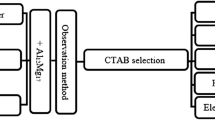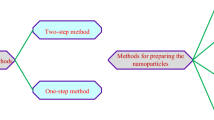Abstract
In the present work, an investigation on the relationship between clustering phenomenon and thermal conductivity of nanofluids is presented. Particularly, an experimental campaign was carried out to correlate mean dimension of cluster, ranging from 168 to 20,933 nm, to nanofluid’s thermal behavior. A further objective of this study was to evaluate how the stability of nanofluid can affect thermal conductivity measurements, carried out by means of hot-wire technique. Experimental results showed that thermal conductivity, measured at constant volume concentration of nanoparticles as a function of cluster dimension, first decreases and then augments, as it was under a dual effect: negative in case of small clusters and positive with big clusters within nanofluid. Actually, further measurements of zeta potential and backscattered light demonstrated that clustering reduces nanofluid’s thermal conductivity, while its increment can be related to sedimentation of clusterized particles, which produces convective motion around the hot wire, generating overestimated measurements.








Similar content being viewed by others
Abbreviations
- A :
-
Surface [m2]
- d :
-
Average diameter of nanoparticles [m]
- d cl :
-
Average diameter of clusters [m]
- h :
-
Height of cuvette used to perform backscattered light spot analysis [m]
- T :
-
Temperature [T]
- X V :
-
Volume fraction of suspension
- X DW :
-
Volume fraction of deionized water
- λ :
-
Thermal conductivity of nanofluid [W m−1 K−1]
- λ 0 :
-
Thermal conductivity of base fluid [W m−1 K−1]
- zP :
-
Zeta potential [V]
- k B :
-
Boltzmann constant [J K−1]
- BF:
-
Base fluid
- NP:
-
Nanoparticle
- NF:
-
Nanofluid
- BS:
-
Backscattered light spot
References
Maxwell JC. Treatise on electricity and magnetism. Oxford: Clarendon Press; 1873.
Choi SUS, Eastman JA. Enhancing thermal conductivity of fluids with nanoparticles. San Francisco: ASME; 1995.
Bashirnezhad K, Bazri S, Safaei MR, Goodarzi M, Dahari M, Mahian O, Dalkılıça AS, Wongwises S. Viscosity of nanofluids: a review of recent experimental studies. Int Commun Heat Mass. 2016;73:114–23.
Magesh Babu D, Nagarajan PK, Madhu B, Ravishankar S. Experimental evaluation of friction factor and heat transfer enhancement of twisted tape inserts using TiO2–water nanofluids. J Eng Thermophys. 2017;26:567–79.
Colangelo G, Favale E, De Risi A, Laforgia D. A new solution for reduced sedimentation flat panel solar thermal collector using nanofluids. Appl Energy. 2013;111:80–93.
Stalin PMJ, Arjunan TV, Matheswaran MM, Sadanandam N. Experimental and theoretical investigation on the effects of lower concentration CeO2/water nanofluid in flat-plate solar collector. J Therm Anal Calorim. 2017. https://doi.org/10.1007/s10973-017-6865-4.
Yu W, Choi SUS. The role of interfacial layers in the enhanced thermal conductivity of nanofluids: a renovated Maxwell model. J Nanopart Res. 2003;5:167–71.
Leong KC, Yang C, Murshed SMS. A model for the thermal conductivity of nanofluids—the effect of interfacial layer. J Nanopart Res. 2006;8:245–54.
Milanese M, Iacobazzi F, Colangelo G, de Risi A. An investigation of layering phenomenon at the liquid–solid interface in Cu and CuO based nanofluids. Int J Heat Mass Transf. 2016;103:564–71.
Huaqing X, Motoo F, Xing Z. Effect of interfacial nanolayer on the effective thermal conductivity of nanoparticle-fluid mixture. Int J Heat Mass Transf. 2005;48:2926–32.
Keblinski P, Phillpot SR, Choi SUS, Eastman JA. Mechanisms of heat flow in suspensions of nano-sized particles (nanofluids). Int J Heat Mass Transf. 2002;45:855–63.
Ceylan A, Jastrzembski K, Shah SI. Enhanced solubility Ag–Cu nanoparticles and their thermal transport properties. Metall Mater Trans A. 2006;37A:2033–8.
Avsec J. The combined analysis of phonon and electron heat transfer mechanism on thermal conductivity for nanofluids. Int J Heat Mass Transf. 2008;51:4589–98.
Prasher R, Bhattacharya P, Phelan PE. Thermal conductivity of nanoscale colloidal solutions (nanofluids). Phys Rev Lett. 2005;94:025901.
Bhattacharya P, Saha SK, Yadav A, Phelan PE, Prasher RS. Brownian dynamics simulation to determine the effective thermal conductivity of nanofluids. J Appl Phys. 2004;95:6492–4.
Li CH, Peterson GP. Mixing effect on the enhancement of the effective thermal conductivity of nanoparticle suspensions (nanofluids). Int J Heat Mass Transf. 2007;50:4668–77.
Kapitza PL. Zh. Eksp. Teor. Fiz. 11, 1 (1941) (J. Phys. (USSR)4, 181 (1941)); also in Collected Papers of P. L. Kapitza, Vol. 2, D. ter Haar, ed. (Pergamon, Oxford, 1965), p. 581.
Khalatnikov IM. Zh. Eksp. Teor. Fiz. 22, 687, 1952 (Sov. Phys. JETP 22, 687 (1952)).
Swartz ET, Pohl RO. Thermal boundary resistance. Rev Mod Phys. 1989;61:605.
Iacobazzi F, Milanese M, Colangelo G, Lomascolo M, de Risi A. An explanation of the Al2O3 nanofluid thermal conductivity based on the phonon theory of liquid. Energy. 2016;116:786–94.
Lomascolo M, Colangelo G, Milanese M, de Risi A. Review of heat transfer in nanofluids: conductive, convective and radiative experimental results. Renew Sustain Energy Rev. 2015;43:1182–98.
Evans W, Prasher R, Fish J, Meakin P, Phelan P, Keblinski P. Effect of aggregation and interfacial thermal resistance on thermal conductivity of nanocomposites and colloidal nanofluids. Int J Heat Mass Transf. 2008;51:1431–8.
Gao JW, Zheng RT, Ohtani H, Zhu DS, Chen G. Experimental investigation of heat conduction mechanisms in nanofluids. Clue on clustering. Nano Lett. 2009;9:4128–32.
Prasher R, Phelan PE, Bhattacharya P. Effect of aggregation kinetics on the thermal conductivity of nanoscale colloidal solutions (nanofluid). Nano Lett. 2006;6:1529–34.
Tahmooressi H, Daviran S, Kasaeian A, Rashidi A. Percolating micro-structures as a key-role of heat conduction mechanism in nanofluids. Appl Therm Eng. 2017;114:346–59.
Daviran S, Kasaeian A, Tahmooressi H, Rashidi A, Wenc D, Mahian O. Evaluation of clustering role versus Brownian motion effect on the heat conduction in nanofluids: a novel approach. Int J Heat Mass Transf. 2017;108:822–9.
Lee JH, Lee SH, Jang SP. Do temperature and nanoparticle size affect the thermal conductivity of alumina nanofluids? Appl Phys Lett. 2014. https://doi.org/10.1063/1.4872164.
Wu C, Cho TJ, Xu J, Lee D, Yang B, Zachariah MR. Effect of nanoparticle clustering on the effective thermal conductivity of concentrated silica colloids. Phys Rev E. 2010;81:011406.
Xuan Y, Li Q, Hu W. Aggregation structure and thermal conductivity of nanofluids. AIChE J. 2003;49:1038–43.
Cai J, Hua X, Xiao B, Zhou Y, Wei W. Recent developments on fractal-based approaches to nanofluids and nanoparticle aggregation. Int J Heat Mass Transf. 2017;105:623–37.
Wei W, Cai J, Hu X, Han Q, Liu S, Zhou Y. Fractal analysis of the effect of particle aggregation distribution on thermal conductivity of nanofluids. Phys Lett A. 2016;380:2953–6.
Hong KS, Hong TK, Yang HS. Thermal conductivity of Fe nanofluids depending on the cluster size of nanoparticles. Appl Phys Lett. 2006. https://doi.org/10.1063/1.2166199.
Karthikeyan NR, Philip J, Raj B. Effect of clustering on the thermal conductivity of nanofluids. Mater Chem Phys. 2008;109:50–5.
Sadeghy R, Haghshenasfard M, Etemad SG, Keshavarzi E. Investigation of alumina nanofluid stability using experimental and modified population balance methods. Adv Powder Technol. 2016;27:2186–95.
Gowda R, Sun H, Wang P, Charmchi M, Gao F. Effects of particle surface charge, species, concentration, and dispersion method on the thermal conductivity of nanofluids. Adv Mech Eng. 2015;2010:1–10.
Khanafer K, Vafai K. A critical synthesis of thermophysical characteristics of nanofluids. Int J Heat Mass Transf. 2011;54:4410–28.
Somiya S. Handbook of advanced ceramics. Amsterdam: Elsevier Academic Press; 2013.
Bogdan N, Vetrone F, Ozin GA, Capobianco JA. Synthesis of ligand-free colloidally stable water dispersible brightly luminescent lanthanide-doped upconverting nanoparticles. Nano Lett. 2011. https://doi.org/10.1021/nl1041929.
Lee J, Kim M, Hong CK, Shim SE. Measurement of the dispersion stability of pristine and surface-modified multiwalled carbon nanotubes in various nonpolar and polar solvents. Meas Sci Technol. 2007. https://doi.org/10.1088/0957-0233/18/12/005.
Zhang Z, Cai J, Chen F, Li H, Zhang W, Qi W. Progress in enhancement of CO2 absorption by nanofluids: a mini review of mechanisms and current status. Renew Energy. 2018;118:527–35.
Colangelo G, Favale E, Milanese M, Starace G, de Risi A. Experimental measurements of Al2O3 and CuO nanofluids interaction with microwaves. J Energy Eng. 2017. https://doi.org/10.1061/(ASCE)EY.1943-7897.0000400.
Couto HJB, Nunes DG, Neumann R, França SCA. Micro-bubble size distribution measurements by laser diffraction technique. Miner Eng. 2009;22:330–5.
dos Santos WN. Advances on the hot wire technique. J Eur Ceram Soc. 2008;28:15–20.
Buron H, Mengual O, Meunier G, Cayre´ I, Snabre P. Optical characterization of concentrated dispersions: applications to laboratory analyses and on-line process monitoring and control. Polym Int. 2004. https://doi.org/10.1002/pi.1231.
Colangelo G, Favale E, Miglietta P, Milanese M, de Risi A. Thermal conductivity, viscosity and stability of Al2O3-diathermic oil nanofluids for solar energy systems. Energy. 2016;95:124–36.
Tan KH, Tajuddin HA, Johan MR. Feasibility study on the use of the seeding growth technique in producing a highly stable gold nanoparticle colloidal system. J Nanomater. 2015. https://doi.org/10.1155/2015/537125.
Author information
Authors and Affiliations
Corresponding author
Rights and permissions
About this article
Cite this article
Iacobazzi, F., Milanese, M., Colangelo, G. et al. A critical analysis of clustering phenomenon in Al2O3 nanofluids. J Therm Anal Calorim 135, 371–377 (2019). https://doi.org/10.1007/s10973-018-7099-9
Received:
Accepted:
Published:
Issue Date:
DOI: https://doi.org/10.1007/s10973-018-7099-9




